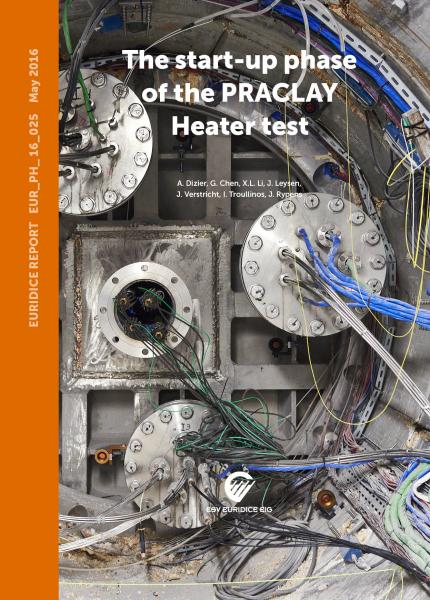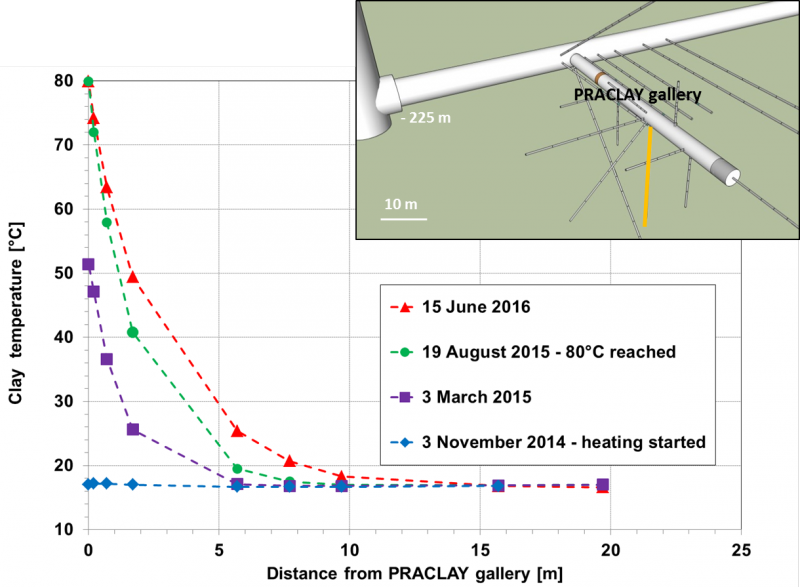Large-scale heating experiment yields first results
In the PRACLAY gallery of the underground laboratory HADES in Mol, the EIG EURIDICE is carrying out a large-scale heating experiment. On 19 August 2015 the temperature around the gallery reached the intended 80°C. It marked the beginning of the 10-year heating phase at a constant temperature of 80°C.

First report available
The most important measurement results of the start-up phase have now been compiled in a first scientific report 'The start-up phase of the PRACLAY Heater test'.
Besides the main observations, the report contains a first comparison with the predictive calculations on the evolution of temperature and pressure in the clay. These 'predictions' are based on measurement results of small-scale heating experiments carried out in the underground laboratory HADES in the past. One of the main objectives of the experiment is to determine the correctness of the model calculations and, if necessary, refine them.
A printed copy of the report can be requested at info@euridice.be .
In the coming years, reports will be published with a detailed interpretation of all observations and an evaluation of the different success criteria of the experiment. Naturally, we will keep you informed.
20th Exchange Meeting
On Wednesday 4 May 2016, the EIG EURIDICE organised the 20th Exchange Meeting to present both the first results of the experiment and the current situation. Exchange Meetings are scientific information sessions in English, organised annually by EURIDICE together with its two members, ONDRAF/NIRAS and SCK•CEN. The main objective is to inform all fellow scientists involved in the broad research programme on geological disposal on the progress made on different aspects of the scientific research.
All presentations of this and previous Exchange Meetings are available here. If you are interested in participating in the next Meeting, please contact info@euridice.be .
Current situation
The graph below shows the evolution of the temperature during the first ten months after reaching the intended temperature of 80°C where the concrete gallery lining and the clay meet. Since then, the temperature at the contact point with the clay has been kept constant. Further into the clay the temperature is still increasing as the warmth is slowly spreading throughout the clay. The displayed temperature measurements are those in a vertical borehole (yellow line on the drawing), leaving from the middle of the heated part of the gallery. The temperature measurements confirm the existing models.

| Figure - The points on the dashed lines show the temperature (T) of the clay in function of the distance to the gallery, measured in a 20 metre long vertical borehole (yellow on the figure above). At the start, the natural temperature in the clay was 17°C (blue curve). On 19 August the intended temperature of 80°C where the gallery meets the clay was reached (green curve). Since then, the temperature on the contact with the clay has been kept constant. Further away from the gallery the temperature continues to rise. The red curve represents the situation on 15 June 2016. |
Why are researchers conducting this experiment?
Influence of heat
High-level radioactive waste gives off heat. When this waste, after the foreseen cooling period of 60 years at the surface, is disposed of underground, the clay surrounding the disposal galleries will heat up. Small-scale heating experiments have already shown that the clay retains its ability to contain radioactive substances when it is heated.. Now the researchers aim to confirm and further refine the current knowledge on the behaviour and properties of clay when heated at a scale representative of an actual disposal facility. Moreover, the PRACLAY experiment offers the opportunity to study the influence of temperature increase on the stability of the concrete gallery lining in circumstances similar to those in a real disposal facility. This knowledge is important with a view to evaluating the possible retrievability of the waste. Finally, the experiment also offers a unique opportunity to test the reliability of the measurement instruments used, at elevated temperatures and over a long period of time.
Would you like to know more about the PRACLAY experiment? Make sure to read our first newsletter.

